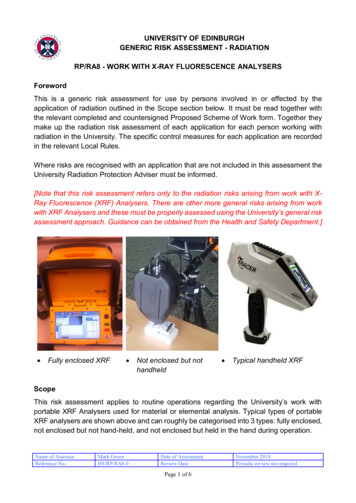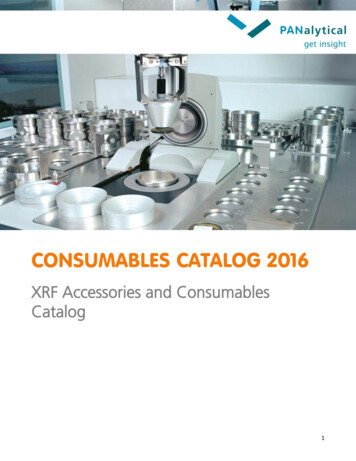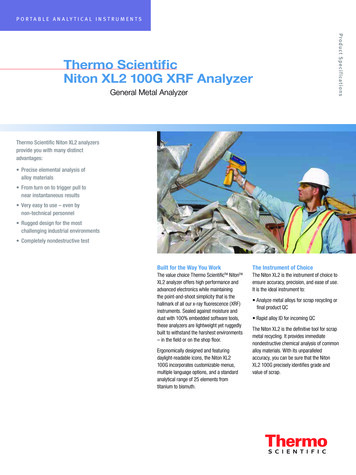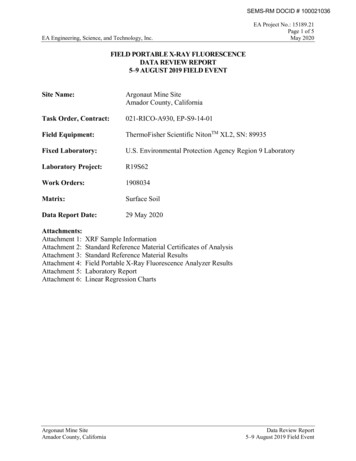
Transcription
UNIVERSITY OF EDINBURGHGENERIC RISK ASSESSMENT - RADIATIONRP/RA8 - WORK WITH X-RAY FLUORESCENCE ANALYSERSForewordThis is a generic risk assessment for use by persons involved in or effected by theapplication of radiation outlined in the Scope section below. It must be read together withthe relevant completed and countersigned Proposed Scheme of Work form. Together theymake up the radiation risk assessment of each application for each person working withradiation in the University. The specific control measures for each application are recordedin the relevant Local Rules.Where risks are recognised with an application that are not included in this assessment theUniversity Radiation Protection Adviser must be informed.[Note that this risk assessment refers only to the radiation risks arising from work with XRay Fluorescence (XRF) Analysers. There are other more general risks arising from workwith XRF Analysers and these must be properly assessed using the University’s general riskassessment approach. Guidance can be obtained from the Health and Safety Department.] Fully enclosed XRF Not enclosed but nothandheld Typical handheld XRFScopeThis risk assessment applies to routine operations regarding the University’s work withportable XRF Analysers used for material or elemental analysis. Typical types of portableXRF analysers are shown above and can roughly be categorised into 3 types: fully enclosed,not enclosed but not hand-held, and not enclosed but held in the hand during operation.Name of AssessorReference No.Mark GreenHS/RP/RA8.0Date of AssessmentReview DatePage 1 of 6November 2018Periodic review not required
Hazards-Irradiation of part or whole of the body to external x radiation during normal use.Irradiation of part or whole of the body to external x radiation in case of an accident;Persons likely to be exposed to the hazard: University staff, research staff, students,visiting workers, other workers (e.g. interns) and members of the public. Pregnant womenand persons less than 18 years old would be at particular risk.Risk before the implementation of control measures:Category of PersonHighUniversity staff, research staff, students, visitingworkers and other workers (e.g. interns)Medium Members of the public Persons particularly at risk: Low Pregnant women and young personsThe radiation levels in the main beam of an XRF analyser can be very high and can exceed1Sv/h at the aperture and can still exceed 1mSv/h at 50cm.Scattered radiation levels are very much dependant on the sample being analysed and thetype of XRF equipment used. Typically, scattered radiation levels are very low for fullyenclosed XRF equipment or for equipment where the x-ray beam is focussed onto a smallarea of the sample (e.g. around 1 mm2).Scattered radiation levels from hand-held XRF devices can typically be up to 500 µSv/h at10cm around the front of the instrument near the aperture/sample but are generally lessthan 1 µSv/h at the trigger and at other areas around the unit away from the aperture.Reasonably foreseeable accidents:Type of IncidentPossible EffectsX-rays don’t switch off when asked to do so.Exposure to the main beam resulting inan unnecessary radiation exposure abovea dose limit.Equipment begins generating x-rays when ithas not been asked to.Exposure to the main beam resulting inan unnecessary radiation exposure abovea dose limit.A failure (i.e. mechanical, electrical oraccidental damage) resulting in a person orpersons being exposed to the x-ray beamExposure to the main beam resulting inan unnecessary radiation exposure abovea dose limit.Name of AssessorReference No.Mark GreenHS/RP/RA8.0Date of AssessmentReview DatePage 2 of 6November 2018Periodic review not required
Type of IncidentPossible EffectsProcedural failure resulting in an unintendedexposureExposure to the main beam resulting inan unnecessary radiation exposure abovea dose limit.Accident leading to an overexposureSkin reddening unlikely to occur unlessexposure in excess of 1hr; Exposure tothe main beam resulting in anunnecessary radiation exposure potentialrestriction of work duties following theoverexposureUnauthorised use of the equipmentExposure to the main beam or scatteredradiation resulting in an unnecessaryradiation exposure above a dose limit.Theft / loss of the equipmentExposure to the main beam or scatteredradiation resulting in an unnecessaryradiation exposure above a dose limit.Justification and OptimisationIt is assumed that the analysis of materials by XRF is needed to fulfil the desired work. Theuse of radiation generators for detection and analysis is an existing justified practice 1.Control MeasuresAt the design or procurement stage for a project utilising an XRF analyser, considerationshould first be given to whether the x-ray hazard can be engineered out; for example, bycarrying out the work using a fully-enclosed piece of equipment or in an interlockedenclosure. It is always better to minimise the risk of exposure to x radiation using engineeringcontrols than to minimise the risk using procedural and behavioural controls.Technical All XRF analysers, must:o Have a clear warning label on them to indicate that they are capable of emittingionising radiation. This should be in a prominent position on the front of theinstrument.o Have some form of key-operation or password protection to preventunauthorised use of the equipment.o Have sufficient shielding to ensure leakage dose rates are not greater than 3µSv/h around the equipment (except at the aperture);o Have a warning light to indicate when x-rays are being k/government/uploads/system/uploads/attachment data/file/717288/180618 JustificationGuidanceDoc updatedannex.pdfName of AssessorReference No.Mark GreenHS/RP/RA8.0Date of AssessmentReview DatePage 3 of 6November 2018Periodic review not required
o Have a maintenance contract in place, or if this is not required for warrantypurposes, at least access to the manufacturer who can check that theequipment is performing as expected.o Only be repaired/maintained by properly trained and authorised persons (i.e.by the manufacturer or an agent of the manufacturer).o Be taken out of service if they are thought to be damaged or if any of the safetyfeatures are not working. XRF analysers that are ‘fully-enclosed’ must also have:o Adequate shielding such that the radiation dose rate at any point on contactwith the surface of the equipment does not exceed 3 µSv/h.o Any access points (e.g. door(s), hatch(es), panel(s)) either interlocked orfixed/bolted down to prevent access to the main x-ray beam. Opening of anyof these access points must close the shutter on the x-ray tube or de-energisethe x-ray generator. XRF analysers where access to the main beam is permitted under normal conditionsof use must also:o If hand-held, have a two-handed option which ensures the user has bothhands on the equipment during measurements;o If hand-held, have an exposure control trigger on the instrument that ifreleased, stops the x-rays being generated;o Ideally have both of the safety features outlined below, but where this is notpracticable, at least one of them must be fitted: A proximity sensor which is enabled under normal conditions of use toprevent x-rays being generated when there is not a sample held againstthe aperture; A low-count backscatter detector to turn off the x-rays if at any point inthe measurement it detects a low count (e.g. if the sample has beenmoved away from the aperture/sample area);o Not permit reinstatement of the x-ray emission if the x-ray emission isinterrupted at any point during the measurement (e.g. if the sample is movedaway from the aperture and the x-rays stop, the mere act of moving the sampleback in front of the aperture must not re-start the measurement). A manualintervention must be made to restart x-ray emission.Procedural The procedures for safe operation of XRF analysers must be written down in LocalRules.Where access to the primary x-ray beam is possible under normal conditions of use,a Controlled Area must be set up whenever the equipment is in a ready-state suchthat it is capable of producing x-rays.Name of AssessorReference No.Mark GreenHS/RP/RA8.0Date of AssessmentReview DatePage 4 of 6November 2018Periodic review not required
Where access to the primary x-ray beam is possible under normal conditions of use,a suitable real-time radiation monitor must be used to detect enhanced levels ofradiation in the area. This can be achieved by either placing a hand-held radiationmonitor such as the Mini Instruments 900 type ‘E’ in the Controlled Area near thesample or by the operator wearing a suitable Electronic Personal Dosimeter (EPD).Where practicable, operate the XRF analyser from outside the designated ControlledArea.Only essential personnel must remain in the Controlled Area during measurements.If a person’s presence in the Controlled Area is essential, they should positionthemselves as far away from the x-ray equipment or sample as practicable (note, theoperator may need to be close to the equipment if they are operating a hand-heldXRF analyser).The shortest measurement time to achieve the desired result must be used.Where practicable, e.g. for small samples, carry out measurements in a shieldedenclosure which is interlocked to prevent access to the main x-ray beam.Operation of XRF equipment must only be by persons trained in the correct use ofthe equipment.The equipment must be kept secure when not in use.The operator must wear a whole-body radiation dosemeter or extremity dosimeterduring measurements if this advised in the Local Rules or PSoW form.Visual inspection of the equipment for damage must be carried out by the operatorbefore use.If the XRF equipment is to be left unattended for any length of time or when it is notbeing used, it must be made safe. For example, by disconnecting the battery pack,by disconnecting cables that permit x-ray generation or by activating passwordprotection on the equipment or enabling software.Plans must be drawn up and included in the Local Rules for procedures in case ofthe accidents listed above.Behavioural Persons operating fully-enclosed XRF equipment, where there is NO practical accessto the main x-ray beam, do not require specific radiation safety training and canachieve adequate information and instruction by:o Reading the relevant University Radiation Protection Unit Guidance Note onenclosed x-ray apparatus;o Completing the relevant PSoW for enclosed x-ray apparatus; and,o Receiving local instruction on the general use of the equipmentPersons operating XRF equipment where there IS access to the main beam undernormal conditions of use must be authorised using the University’s radiationauthorisation arrangements, which includes the radiation protection trainingarrangements.Name of AssessorReference No.Mark GreenHS/RP/RA8.0Date of AssessmentReview DatePage 5 of 6November 2018Periodic review not required
A Radiation Protection Supervisor must be appointed to provide suitable supervisionof the use of XRF equipment where there is access to the main x-ray beam undernormal conditions of use.For XRF equipment in which there is no access to the main x-ray beam under normalconditions of use (i.e. for fully-enclosed XRF equipment), the following is advised:o If an RPS is appointed for the area, appoint the RPS to carry out localequipment training and to countersign PSoW forms.o If no RPS is appointed for the area, the default position is that the LineManager takes responsibility for local equipment training and to countersignPSoW forms.The appointed RPS must be trained in the measures required to ensure compliancewith the controls outlined in this risk assessment and with the Local Rules.For XRF analysers that are not fully enclosed, the main x-ray beam must neverdeliberately be pointed at any part of the body.Samples must never be held in the hand during measurements.Dose ConstraintNo special dose constraint is required for work with XRF analysers.Dose Investigation LevelIn view of the fact that the majority of the risks can be controlled by technical means andscattered radiation levels are generally low, classified workers should not be required forwork with XRF analysers.The need for personal dosimetry for XRF analysers depends on the type of analyser (e.g.fully enclosed or not) and is discussed in the relevant Local Rules for the XRF equipment.The need for personal dosimetry is then communicated to the users by return of theirProposed Scheme of Work form.Dose investigation levels are set out in the relevant Local Rules for the XRFequipment but will not exceed a cumulative dose of 6mSv over the year.Risk after the implementation of control measures:Category of PersonHighMediumLowUniversity staff, research staff, students, visitingworkers and other workers (e.g. interns) Members of the public Persons particularly at risk: pregnant women andyoung persons Name of AssessorReference No.Mark GreenHS/RP/RA8.0Date of AssessmentReview DatePage 6 of 6November 2018Periodic review not required
type of XRF equipment used. Typically, scattered radiation levels are very low for fully enclosed XRF equipment or for equipment where the x-ray beam is focussed onto a small area of the sample (e.g. around 1 mm 2). Scattered radiation levels from handheld XRF devices can typically be up to 500 - µSv/h at










